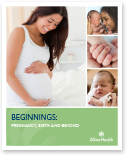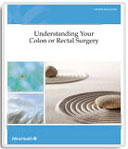
Manuals by Allina Health's Patient Education Department
Cancer care

Esophageal or Gastric (Stomach) Cancer
The following information will help explain what will happen during your surgery, what to expect during your hospital stay and how to care for your J-tube dressing.
Understanding Esophageal Cancer
Your Gastric Stomach Cancer Surgery
How to Change a Jejunostomy Tube (J-tube) Dressing

Understanding Breast Cancer: Information About Treatment and Recovery
After you find out you have breast cancer, it is easy to feel overwhelmed or confused. Along with your health care team, this manual will help educate and guide you through your breast cancer diagnosis and treatment plan.

Understanding Bladder Cancer
This manual was created to educate, help and guide you through your bladder cancer diagnosis and treatment plan. This is a general overview of bladder cancer and not everything may apply to your situation.

Understanding Gynecologic Cancer
This manual was created to educate, help and guide you through your gynecologic cancer diagnosis and treatment plan.

Understanding Melanoma
This manual was created to educate, help and guide you through your melanoma diagnosis and treatment plan.

Your Lung Surgery
This manual explains what will happen during your lung surgery and what to expect during your hospital stay and when you go home.
Diabetes

Basic Skills for Living with Diabetes
Whether you have just been told that you have diabetes or you've had the disease for years, we can help you manage your diabetes. This manual by the Allina Diabetes Education Council includes what people with diabetes need to know.
Prediabetes: Reducing Type 2 Diabetes Risk Through a Lifestyle of Good Nutrition and Activity
This comprehensive manual can help you understand what prediabetes is, if you are at risk for type 2 diabetes, and how to prevent diabetes by making small lifestyle changes.
Nutrition

The "Whole" Truth About Food
If you've ever found yourself frustrated with nutrition information in the media ("Eggs are good!" "No, they're bad!"), confused by health claims on the front of a food package ("all natural," "gluten free") or distracted by dieting fads (keto, paleo), you're not alone! Knowing what and how much to eat is important for your health and well-being.
This manual will help you understand the "whole" truth about food and which foods work best for your body, and will give you the information and tools you need to achieve your goal(s).
Heart disease and heart health

All about your heart
The more you know about how your heart works and what you can do to help it work better, the healthier and more in control of your life you'll feel.
This sections pulls from various stand-alone pieces created by Allina Health's Patient Education Department and replaces the discontinued "Helping Your Heart" manual.

ECMO
This book will teach you more about ECMO, a life-support machine that supports you or your loved one’s lungs and heart.

Heart Failure
Although heart failure cannot be cured, it can be managed through diet, exercise and medicine. That is why Allina experts developed this guide to living and succeeding with heart failure.

Heart Surgery
This book will guide you before, during and after your surgery. Your health care team will plan and guide you through each step of your treatment, from pre-surgery teaching through recovering after your surgery.
Pregnancy and parenting

Beginnings: Pregnancy, Birth & Beyond
This award-winning guide to pregnancy describes what to expect during pregnancy, how to prepare for labor, what to expect during recovery, and how to care for a newborn. It also includes detailed worksheets, forms, checklists and a resources section.

Gestational Diabetes: When You Have Diabetes during Pregnancy
Unlike other forms of diabetes, gestational diabetes lasts only as long as you are pregnant. This manual can help you understand what's happening to your body, how gestational diabetes is affecting you and your baby, and how it can be controlled.

Guide for the Care of Children: Ages Birth to 5
This guide can help answer your questions about infant/baby care, infections, diseases and allergies, safety precautions and emergencies, well checkups, as well as other issues parents usually face.
Stroke

Understanding Stroke
If you have had a stroke or are caring for someone who had a stroke, we can help.
Surgery and hospitalization

Surgery: What You Need to Know
This manual can help ease your mind about having an operation by letting you know what to expect before surgery and after surgery.

Understanding Your Colon or Rectal Surgery
This manual will walk you through what to expect if you are having colon or rectal surgery and can help you prepare for surgery and guide you through recovery.

Heart Transplant
This manual gives basic information about having a heart transplant. The goal of the heart transplant is to add years to your life and improve the quality of your life.

Hip Replacement
This manual will help you prepare for hip surgery and guide you through your recovery.
You may also download a PDF copy of Hip Replacement.

Preparing for Your Hysterectomy
How do you make your surgery a positive and meaningful experience? This manual was developed to: increase your general knowledge of a hysterectomy, help you prepare for surgery and guide you through recovery.

Knee Replacement
This manual will help you prepare for knee surgery and guide you through your recovery.
You may also download a PDF copy of Knee Replacement.

Shoulder Replacement
This manual will help make your shoulder replacement surgery a positive and meaningful experience and will guide your through your recovery.
Ankle Replacement
This manual was created to help you prepare for surgery and guide you through your recovery. The information is not meant to replace advice you receive from your health care team.
Understanding Your Cervical Spine Surgery
This manual will help you prepare for spine surgery (discectomy or laminectomy), including how to prepare for surgery, your hospital stay, and care after surgery. It also includes resources to guide you through your recovery at home.
Understanding Your Spine Surgery
This manual will help you prepare for spine surgery, your hospital stay, and care after surgery. It also includes resources to guide you through your recovery at home.
Understanding Your Spine Surgery: Discectomy and Laminectomy
This manual will help you prepare for spine surgery (discectomy or laminectomy), including how to prepare for surgery, your hospital stay, and care after surgery. It also includes resources to guide you through your recovery at home.

Living Well After a Hospital Stay: A Guide for Older Adults and Their Care Circles
Being hospitalized can be a stressful event for you and your care circle (family, friends and others close to you). This booklet was created to help guide you through your experience.
Weight Management

Allina Health Weight Management Medical Program
Learn about weight loss through non-surgical means.

Allina Health Weight Management Surgery Program
Learn about surgical weight loss including before- and after-surgery guidelines.




